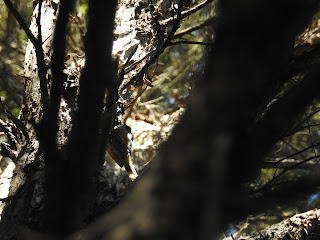On our last full day in Berlin, my father and I went on a birding tour with Rolf from birdingberlin.com. We saw a wide variety of birds, most of which were new for us.
We first arrived at a railway station in the Havelland area, where Rolf agreed to pick us up. While in the station area, we saw a distant
common buzzard. Interesting songbirds in the area included a
serin and a female
black redstart, though I only managed to photograph the
serin. Soaring overhead
was a distant
red kite, as well as an equally distant
Eurasian sparrowhawk.
This serin was singing loudly from the top of a tree
This shot of a red kite really doesn't do the bird justice
We then visited a forest. Here we saw several new birds, though I didn't manage to photograph them. Species seen included
house wrens, great spotted woodpeckers, a single
wood warbler and several young
blue tits. The main star of the visit to the forest was a pair of two distant
common cranes.
Through Rolf's scope, the beauty of these common cranes was far more evident
After that we visited a village filled with the nests of
white storks. I will not put any stork photos in this post and will instead post a gallery of the storks we saw. There was also a colony of
house martins. Singing in a nearby shrub was a
lesser whitethroat, though we couldn't get a good look at it. Finally, while we were there two
Eurasian kestrels flew into the village. One attempted to harass a stork, but to no avail.
A house martin at its nest
This Eurasian kestrel was perched high on a church, near the nest of a stork
The next stop was a wetland. Here the birds were quite distant, so again Rolf's scope was put to use. Through scanning the area we spotted
red-necked grebes, mallards, gadwalls, Northern shovelers, Eurasian wigeons, little grebes, red-crested pochards and
greylag geese feeding in the water. A distant
western marsh harrier, along with a few soaring
black kites and
common buzzards, hunted over the area. Finally, in the trees on the far side of the wetland were 2 calling
Eurasian cuckoos.
In this flock of waterfowl, coots, red-crested pochards, gadwalls and mallards can be seen
A distant red-necked grebe. We saw 2 of these grebes performing a courtship ritual
Another distant grebe, this time a little grebe
This Eurasian cuckoo was calling loudly, but only showed itself for a few seconds
In case you haven't seen enough distant birds, have a look at this Western marsh harrier
We had lunch and followed a trail to an observation tower. On the way to the tower Rolf found a small moor frog (Rana arvalis). This tower overlooked reeds on one side and a colony of common terns and black-headed gulls on the other. While watching the reeds we saw a variety of birds: reed warblers, greater reed warblers, reed buntings, chiffchaffs and sedge warblers were all present. Rolf and my father also got a brief glimpse of a penduline tit, but nobody else in the group could find it before it flew off.
The chiffchaff's only real distinguishing feature is its song
Moor frogs are common in much of Europe
The common reed warbler is smaller and not as loud as the great reed warbler
Several sedge warblers were flying in and out of the reeds
Black-headed gulls and common terns were in abundance at the colony
Our next stop was another observation tower. This tower overlooked a large protected grassland, where great bustards could be found. We had no luck with the bustards, but saw a variety of birds in the area around the tower. From the tower, several common cranes could be viewed through Rolf's scope. The tower itself was being used as a nesting ground by barn swallows, who squawked angrily at us as we walked up to the top floor. Yellow wagtails, white wagtails, corn buntings, skylarks and linnets were all present in the area around the tower, though of these I only got good photographs of the buntings. A small pond held a single moorhen. The best bird we saw from here was a distant male hen harrier, soaring leisurely over the grassland.
Many of these barn swallows were calling at us
This corn bunting came quite close to the tower before flying away
On the way to our final destination, we stopped because Rolf had heard the call of an Ortolan bunting. We managed to get some glimpses of the bunting flying off, but didn't get any photos of it. However, we did get photos of a chaffinch who we initially mistook for as the bunting. We stopped once more to view a distant osprey nest. The nest was also being inhabited by some Eurasian tree sparrows, using the osprey's presence as protection from predators.
Though not an Ortolan bunting, this chaffinch was still a nice find
Our final stop was the Guelper See. This large lake held many Greylag geese, along with distant common terns, black-headed gulls and Caspian gulls. A single Northern lapwing could be seen far away, along with an even more distant black tern which we viewed through Rolf's scope.
Greylag geese are quite common in Germany
After that very successful trip, we took the train home. If in the area I would highly recommend Rolf's services as a guide: he knew the calls of all the birds, easily identified them and took us to a variety of habitats. You can find details about booking tours with him on birdingberlin.com.
























































